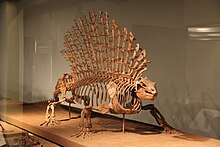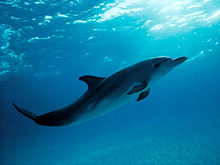Eupelycosauria
| Eupelycosauria | |
|---|---|

| |
Field Museum
| |

| |
| Atlantic spotted dolphin | |
| Scientific classification | |
| Domain: | Eukaryota |
| Kingdom: | Animalia |
| Phylum: | Chordata |
| Clade: | Synapsida |
| Clade: | Eupelycosauria Kemp , 1982
|
| Subgroups | |
| |
Eupelycosauria is a large
Early Pennsylvanian epoch, with the fossils of Echinerpeton and perhaps an even earlier genus, Protoclepsydrops, representing just one of the many stages in the evolution of mammals,[3] in contrast to their earlier amniote
ancestors.
Taxonomy
Eupelycosaurs are
distinguished from the Caseasaurian synapsids by having a long, narrow supratemporal bone (instead of one that is as wide as it is long) and a frontal bone with a wider connection to the upper margin of the orbit.[4] The only living descendants of basal eupelycosaurs are the mammals
.
The group was originally considered a suborder of pelycosaurs or "mammal like reptiles", leaving the other defined subgroup of it, Metopophora, as its synonym.
Evolution
Early Pennsylvanian
Many non-therapsid eupelycosaurs were the dominant land animals from the latest
caseids, were the dominant herbivores in the early part of the Permian. The most renowned edaphosaurid is Edaphosaurus, a large [10–12-foot-long (3.0–3.7 m)] herbivore which had a sail on its back, probably used for thermoregulation and mating. Sphenacodontids, a family of carnivorous eupelycosaurs, included the famous Dimetrodon, which is sometimes mistaken for a dinosaur, and was the largest predator of the period. Like Edaphosaurus, Dimetrodon also had a distinctive sail on its back, and it probably served the same purpose - regulating heat. The varanopid family passingly resembled today's monitor lizards and may have had the same lifestyle.[9]
became extinct
at the end of Permian period.
Classification
The following cladogram is modified from Huttenlocker et al. (2021):[10]
| Synapsida |
| ||||||||||||||||||||||||||||||||||||||||||||||||||||||||||||||||||||||||
References
- ^ a b Spindler, F., R. Wernburg, J. W. Schneider, L. Luthardt, V. Annacker, and R. Roßler. 2018. First arboreal ‘pelycosaurs’(Synapsida:Varanopidae) from the early Permian Chemnitz Fossil Lagerstatte, SE-Germany, with a review of varanopid phylogeny. Palaontologische Zeitschrift. doi: 10.1007/s12542-018-0405-9.
- ^ Neil Brocklehurst & Jörg Fröbisch (2018) A reexamination of Milosaurus mccordi, and the evolution of large body size in Carboniferous synapsids, Journal of Vertebrate Paleontology, 38:5, DOI: 10.1080/02724634.2018.1508026
- ^ Kemp. T.S., 1982, Mammal-like Reptiles and the Origin of Mammals. Academic Press, New York
- Reisz, R. R., 1997, Autapomorphies of the main clades of synapsids - Tree of Life Web Project
- ISBN 3-89937-032-5
- .
- S2CID 209672518.
- ISSN 2296-6463.
- ^ "Synapsida". Palaeos. Archived from the original on 13 March 2006.
- PMID 34925870.
External links
- "Eupelycosauria". Paleos. Archived from the original on May 3, 2006.
- "Main Groups of Non-Mammalian Synapsida". Mikko's Phylogeny Archive. Archived from the original on December 10, 2022.
